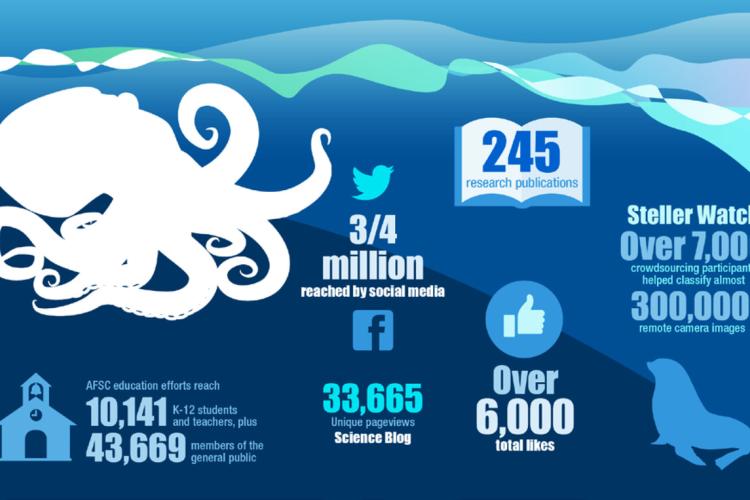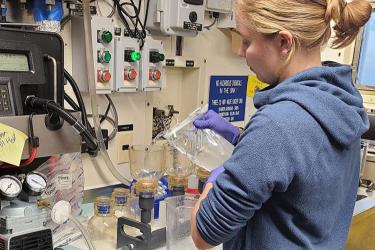Engaging the Public
Critical to the success of our science endeavors is effective communications to build support for the research and then to share research results. We do this by maintaining an ongoing dialogue with fishermen, environmental organizations and Congress and through broader public outreach and education to students, teachers and parents. Such interactions go a long way in promoting mutual trust and respect, a hallmark of Alaska fisheries management.
Stakeholder Engagement Highlights
A big part of our job each year is communicating with the fishing industry, environmental community members and others interested in our research through in-person meetings, collaborative research, phone conversations, office visits, conferences and the Council process. Center staff also work closely with Alaska Native organizations and communities to discuss the rationale for aerial and vessel surveys of bearded seals, ringed seals, polar bears, fish and crab stocks and plankton communities. The goal is to maintain a dialogue and identify ways to minimize disturbance on marine life and Alaska Native hunters and fishermen. To help with this effort, we produced a comprehensive map of all our marine mammal surveys and research projects, posted it on our website and shared it with 426 Alaska Native coastal organizations, agencies, and corporations.
Social Media and Web-Based Platforms
The use of social media and web-based platforms is helping us reach remote villages and Native communities throughout Alaska and people around the world with news and information about our research. Our science blog, “Dispatches from the Field,” had 33,665 unique visits. Our web stories and science blog generated nearly 3⁄4 of a million social media impressions, earning us 6,000 likes on Facebook and Twitter.
K-12 Students and Teachers
We reached 10,141 students and teachers through programs that bring students into our labs for field trips, and take scientists into classrooms. Our long-term educational programs provide a pipeline to keep students engaged in science from kindergarten through high school and beyond. At our Auke Bay Laboratories, in Juneau Alaska, we do this during our annual Sea Week, Sun to Sea Camp, and Southeast Alaska Regional Science Fair activities. In Kodiak, Alaska, we reach students through a partnership with the local community and school, the Ocean Science Discovery Program. Scientists visit Anchorage-area schools each January during the Alaska Marine Science Symposium. We also reach out to Alaska Native communities through events like Bering Sea Days, a school-based event in the Pribilof Islands, which brings scientists, students, teachers and the community together for interactive science learning. Other Alaska Native communities reached in 2016 included Metlakatla and Yakutat. NOAA Science Camp, a summer science camp for middle and high schoolers now in its 14th year, provides hands-on learning experiences to roughly 130 youth each year.
General Education
This year our scientists and educators reached 43,669 people through community festivals, summer camps, lab tours, events at museums and aquariums, and public seminars. Our Kodiak Laboratory hosted over 15,000 visitors this year, many of them cruise ship visitors from around the world. Our Auke Bay Laboratories staff in Juneau reached over 3,000 people this year through lab tours, seminars, community events and summer camp visits. We also participate each year in Seattle’s Fall Fishermen’s Festival and Pacific Marine Expo, and Kodiak’s COMFISH. We also share our science with large audiences at Seattle Aquarium and Pacific Science Center events.
Publications
This year Center scientists authored 245 research publications in peer-reviewed journals as well as produced numerous in-house technical and program reports. To view our publications, visit the Alaska Fisheries Science Center website.
Connecting with Remote Communities through Online Partners and Technology
NOAA Fisheries’ Alaska Fisheries Science Center focused on connecting remote Alaska classrooms with current NOAA science through distance-learning partnerships. Both through a partnership with Alaska’s AKTEACH and by using online conferencing tools like Google Hangouts, scientists were able to connect with Alaska classrooms in St. Paul, Eagle River, Kodiak, Anchorage, Danger Bay and Larsen Bay to talk with students about their research. Through these online partners and technology, NOAA Fisheries is able to reach underserved classrooms and increase students’ awareness of NOAA’s research in Alaska.
New Tools to Engage Citizens and Classrooms in Science
NOAA Fisheries’ Alaska Fisheries Science Center connected classrooms with a new crowdsourcing platform, Steller Watch, which recruits members of the public to view photographs of endangered Steller sea lions in the western Aleutian Islands to contribute to research by scientists on the life history and movements of these animals.
This innovative project sparked the imagination of teachers, some of whom visited the site daily to count sea lions, and view information on current research and conservation efforts for the endangered western population. By engaging classrooms to conduct the citizen science provided by the Steller Watch site, NOAA Fisheries is increasing knowledge and understanding of Steller sea lion conservation and stewardship issues.
Another effort this year was to engage data analysts to write algorithms to automate the reviewing of aerial survey remote camera images. A contest was held via Kaggle, a web- based platform for scientists and marine learning engineers to share information. Once an algorithm is developed it will be possible for machines to help with this now manual task.
Seafood Summit Comes to Seattle
As part of this year’s International Seafood Summit held in Seattle, scientists and members of our Fisheries Observer Program were invited to host an informational station onboard the commercial fishing vessel Alaska Ocean to highlight the sustainable Alaskan pollock fishery. Visitors explored a state-of-the-art catcher-processor vessel to learn about how it operates and to hear how science collected by the center, the North Pacific Observer program, in collaboration with the fishing industry, underpins sustainable fishery management.
Center Celebrates 10th Anniversary of Ted Stevens Marine Research Institute Approximately 400 people attended the 10th anniversary celebration of the opening of the Ted Stevens Marine Research Institute, home to the Alaska Fisheries Science Center’s Auke Bay Laboratories on August 19th. The celebration included a dedication of a marble bench and plaque donated to the lab by the Ted Stevens Foundation in memory of the late Senator for his contributions to fisheries management.
Annual Seaweek Event Draws Big Crowd
The annual Seaweek student field trip visitations to the Ted Stevens Marine Research Institute occurred from April 17 through May 5. Five hundred students (and siblings) from 24 elementary classes and 300 hundred middle school students from 11 classrooms participated in the program. Two hundred teachers and chaperones accompanied the students.



